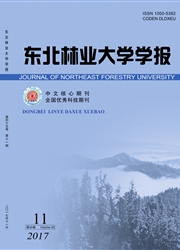

 中文摘要:
中文摘要:
采用动态—密闭气室法(LI-400-09)对紫色土丘陵区3种典型林地土壤呼吸速率进行了连续测定。结果表明:3种供试林地(柏树林、青冈林、桤木林)土壤呼吸速率呈明显的季节变化,并随地下5cm处土温呈相同趋势的多峰波动。青冈(Quercus glauca)、柏树(Cypresses funebris)、桤木(Aldercr cremastogyne)林地平均土壤呼吸速率分别为135.5、150.8、189.5mg·m^-2·h^-1,土壤呼吸速率呈桤木〉柏树〉青冈的趋势。土壤呼吸速率日变化随当日气温先升后降而表现为先增后减的趋势。温度是土壤呼吸的主要影响因子,3种林地(有枯枝落叶覆盖)土壤呼吸速率与地下5cm处土壤温度之间具有极显著的指数相关关系,R^2分别为:R柏树^2=n6838;R青冈^2=0.6645;R桤^2=0.5982。柏树和桤木林地枯枝落叶的存在促进了林地土壤呼吸速率的增长,而青冈林地枯枝落叶对土壤呼吸有抑制作用,表现出一定的屏蔽作用,这种作用随着观测天数的增加而减弱。
 英文摘要:
英文摘要:
Soil respiration rate were measured with a LI-6400 portable photosynthesis system in Cupressus funebris, Quercus glauca, and Alnus cremastogyne forestlands in the hilly area of the central Sichuan basin. Results showed that soil respiration rates changed obviously with different seasons, and the fluctuation with multi-peaks for soil respiration rate was consistent with that for soil temperature at a depth of 5 cm. The mean soil respiration rates in the three types of forestlands were 135.5, 150.8 and 189.5 mg·m^-2·h^-1, showing A, cremastogyne〉 C. funebris 〉 Q. glauca. The daily change of soil respiration rates increased first and then decreased with air temperature ascending first and descending later. Soil temperature was the main factors influencing soil respiration. There was a significant correlation between soil respiration rate and soil temperature at a depth of 5 cm, and the correlation coefficients were 0:683 8, 0.664 5 and 0. 598 2 for A. cremastogyne, C. funebris, and Q. glauca respectively. Soil respiration was promoted by litter fall in A. cremastogyne and C. funebris forestlands , while that was restrained in Q. glauca forestland, indicating that the shielding effect hated gradually with litter decomposition.
 同期刊论文项目
同期刊论文项目
 同项目期刊论文
同项目期刊论文
 期刊信息
期刊信息
